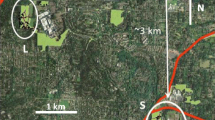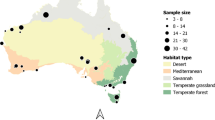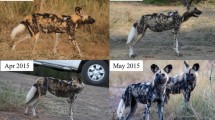Abstract
Understanding factors that limit the productivity and survival of birds in rapidly changing human-dominated landscapes are key to managing future population persistence. To date, few studies have quantified both nest success and post-fledging survival for birds breeding within the suburban matrix. Here, we estimated nest success and juvenile post-fledging survival for Gray Catbirds (Dumatella carolinensis) and used those site-specific parameters to model source–sink dynamics at three sites in suburban Washington DC (USA). Cumulative nest success probability varied substantially among suburban sites and indicated that in some cases suburban habitats may provide suitable breeding sites for passerine birds. In addition, we documented the effects of sex and brood size on post-fledging survival rates and determined the role of predation on dispersing fledglings. Like nest success, estimates of post-fledging juvenile survival also varied among sites and highlight the importance of site-specific demographic estimates in urban habitats. Predation accounted for 79% of all mortalities, with 47% of known predation events attributable to domestic cats (Felis catus). Our models of source–sink dynamics underscore the importance of seasonal recruitment parameters for calculating population growth rate and subsequent persistence. This study provides parameter estimates for two critical life history stages in the avian annual cycle in the suburban matrix and posits that predation drives differential nest and post-fledging survival within human-dominated environments.
Zusammenfassung
Um zu gewährleisten, dass Populationen in der Zukunft fortbestehen, liegt ein Schlüssel im Verständnis der Faktoren, die in sich rasant verändernden, menschendominierten Lebensräumen die Produktivität und das Überleben von Vögeln begrenzen. Bis heute haben nur wenige Studien sowohl den Bruterfolg als auch das Überleben nach dem Ausfliegen von Vögeln untersucht, die in der suburbanen Matrix brüten. Wir haben hier den Bruterfolg und die Überlebensrate von Jungvögeln der Katzendrossel (Dumatella carolinensis) nach dem Ausfliegen bestimmt und verwendeten diese ortsabhängigen Parameter für eine Modellierung der Quellen-Senken-Dynamiken an drei Standorten in Vorstädten von Washington DC (USA). Die kumulierte Bruterfolgswahrscheinlichkeit unterschied sich stark zwischen den Standorten und wies darauf hin, dass in einigen Fällen Vorstadthabitate durchaus passende Brutplätze für Singvögel bieten. Zusätzlich dokumentierten wir den Einfluss von Geschlecht und Brutgröße auf die Überlebensraten nach dem Ausfliegen und bestimmten die Rolle von Prädation auf dispergierende Jungvögel nach dem flügge werden. Ebenso wie der Bruterfolg variierten die Schätzungen der Überlebensraten der Jungvögel nach dem Ausfliegen zwischen den Standorten und unterstreichen die Bedeutung ortsspezifischer demographischer Bestimmungen in städtischen Lebensräumen. Prädation war in 79% die Todesursache, dabei gingen 47% der Prädationsereignisse auf Hauskatzen (Felis catus) zurück. Unsere Modelle der Quellen-Senken-Dynamiken betonen die Bedeutung saisonaler Rekrutierungsparameter zur Berechnung von Wachstumsraten und darauf folgendem Fortbestehen von Populationen. Die vorliegende Arbeit erlaubt Parameterschätzungen für zwei kritische Lebensphasen im Jahreszyklus von Vögeln in der Vorstadtmatrix und stellt heraus, dass in menschendominierten Lebensräumen Prädation maßgeblich zu Unterschieden in der Überlebensrate im Nest und nach dem Ausfliegen führt.



Similar content being viewed by others
References
Adams AAY, Skagen SK, Adams RD (2001) Movements and survival of lark bunting fledglings. Condor 103:643–647
Akaike H (1973) Information theory and an extension of the maximum likelihood principle. In: Petrov BN, Csaki F (eds) Second International Symposium on Information Theory. Budapest: Akademiai Kiado, pp 267–281
Anders AD, Dearborn DC, Faaborg J, Thompson FR III (1997) Juvenile survival in a population of neotropical migrant birds. Conserv Biol 11:698–707
Barratt DG (1997) Predation by house cats Felis catus (L.), in Canberra, Australia. I. Prey composition and preference. Wildl Resour 24:263–277
Best LB, Stauffer DF (1980) Factors affecting nesting success in riparian bird communities. Condor 82:149–158
Blair R (2004) The effects of urban sprawl on birds at multiple levels of biological organization. Ecol Soc 9(5):2. http://www.ecologyandsociety.org/vol9/iss5/art2/
Brittingham M, Temple S (1992) Use of winter bird feeders by black-capped chickadees. J Wildl Manage 56:103–110
Brown BW, Walker H, Schimek M, Wright PR (1979) Life table analysis package for SPSS. Am Stat 33:225–227
Burke DM, Elliott K, Moore L, Dunford W, Nol E, Phillips J, Holmes S (2004) Patterns of nest predation on artificial and natural nests in forests. Conserv Biol 18:381–388
Burnham KP, Anderson DR (2002) Model selection and inference: a practical information theoretic approach, 2nd edn. Springer, New York
Chace JF, Walsh JJ (2006) Urban effects on native avifauna: a review. Landsc Urb Plan 74:46–69
Chamberlin DE, Cannon AR, Toms MP, Leech DI, Hatchwell BJ, Gaston KJ (2009) Avian productivity in urban landscapes: a review and meta-analysis. Ibis 151:1–18
Churcher PB, Lawton JH (1987) Predation by domestic cats in an English village. J Zool Lond 212:439–455
Cimprich DA, Moore FR (1995) Gray catbird (Dumetella carolinensis). The Birds of North America, No. 167. In: Poole A, Gill F (eds) The Birds of North America, Philadelphia, PA
Coleman JS, Temple SA (1993) Rural residents’ free-ranging domestic cats: a survey. Wildl Soc Bull 21:381–390
Coman BJ, Brunner H (1972) Food habits of the feral house cat in Victoria. J Wildl Manag 36:848–853
Cox DR (1972) Regression models and life tables (with discussion). J R Stat Soc B 34:187–220
Donovan TM, Thompson FR III, Faaborg J, Probst JR (1995) Reproductive success of migratory birds in habitat sources and sinks. Conserv Biol 9:1380–1395
Evans E, Abrams E, Roux K, Salmonsen L, Reitsma R, Marra PP (2005) The Neighborhood Nestwatch Program: sense of place and science literacy in a citizen-based ecological research project. Conserv Biol 19:589–594
Fitzgerald BM, Karl BJ (1986) Home range of feral cats (Felis catus L.) in forest of the Orongorongo Valley, Wellington, New Zealand. N Z J Ecol 9:71–81
Fuller RA, Warren PH, Armsworth PR, Barbosa O, Gaston KJ (2008) Garden bird feeding predicts the structure of urban avian assemblages. Divers Distrib 14:131–137
Gaston KJ, Smith RM, Thompson K, Warren PH (2005) Urban domestic gardens (II): experimental tests of methods for increasing biodiversity. Biodivers Conserv 14:395–413
Gering JC, Blair RB (1999) Predation on artificial nests along an urban gradient: predatory risk or relaxation in urban environments? Ecography 22:532–541
Gillies C, Clout M (2003) The prey of domestic cats (Felis catus) in two suburbs of Auckland City. N Z J Zool 259:309–315
Henderson MT, Merriam G, Wegner J (1985) Patchy environments and species survival: chipmunks in an agricultural mosaic. Biol Conserv 31:95–105
Hines JH, Sauer JR (1989) Program CONTRAST: a general program for the analysis of several survival or recovery rate estimates. U.S. Department of the Interior, Fish and Wildlife Service, Washington
Jokimäki J, Huhta E (2000) Artificial nest predation and abundance of birds along an urban gradient. Condor 102:838–847
Jokimaki J, Kaisanlahti-Jokimaki ML, Sorace A, Fernandez-Juricic E, Rodriguez-Prieto I, Jimenez MD (2005) Evaluation of the “safe nesting zone” hypothesis across an urban gradient: a multi-scale study. Ecography 28:59–70
Kaplan EL, Meier P (1958) Nonparametric estimation from incomplete observations. J Am Stat Assoc 53:457–481
Kays RW, DeWan AA (2004) Ecological impact of inside/outside house cats around a suburban nature preserve. Anim Conserv 7:273–283
Kershner EL, Walk JW, Warner RE (2004) Post-fledging movements and survival of juvenile eastern meadowlarks (Sturnella magna) in Illinois. Auk 121:1146–1154
Latta SC, Faaborg J (2002) Demographic and population responses of Cape May warblers wintering in multiple habitats. Ecology 83:2502–2515
Lepczyk CA, Mertig AG, Liu J (2003) Landowners and cat predation across rural-to-urban landscapes. Biol Conserv 115:191–201
Leston LFV, Rodewald AD (2006) Are urban forests ecological traps for understory birds? An examination using Northern cardinals. Biol Conserv 131:566–574
Marra PP, Holmes RT (2001) Consequences of dominance-mediated habitat segregation in American redstarts during the non-breeding season. Auk 118:92–104
Martin TE (1995) Avian life history evolution in relation to nest sites, nest predation, and food. Ecol Monogr 65:101–127
Martin TE, Geupel GR (1993) Nest-monitoring plots—methods for locating nests and monitoring success. J Field Ornithol 64:507–519
Marzluff JM, Withey JC, Whittaker KA, Oleyar MD, Unfried TM, Rullman S, DeLap J (2007) Consequences of habitat utilization by nest predators and breeding songbirds across multiple scales in an urbanizing landscape. Condor 109:516–534
Maxted AM (2001) Post-fledging survival, dispersal, and habitat use in two migratory shrubland bird species. MS thesis, Purdue University, Purdue
Naef-Daenzer B, Widmer F, Nuber M (2001) Differential post-fledging survival of great and coal tits in relation to their condition and fledging date. J Anim Ecol 70:730–738
Newson SE, Leech DI, Hewson CM, Crick HQP, Grice PV (2010) Potential impact of grey squirrels (Sciurus carolinensis) on woodland bird populations in England. J Field Ornithol 151:211–218
Noon BR, Sauer JR (1992) Population models for passerine birds: structure, parameterization, and analysis. In: McCullough DR, Barrett RH (eds) Wildlife 2001: populations. Elsevier, New York, pp 441–464
Powell LA (2007) Approximating variance of demographic parameters using the delta method: a reference for avian biologists. Condor 109:949–954
Pulliam HR (1988) Sources, sinks and population regulation. Am Nat 132:652–661
Pulliam HR (1993) Sources and sinks: empirical evidence and population consequences. In: Rhodes OE, Chesser RK, Smith MH (eds) Population dynamics in ecological space and time. University of Chicago Press, Chicago, pp 45–69
Rappole JH, Tipton AR (1991) New harness design for attachment of radio transmitters to small passerines. J Field Ornithol 62:335–337
Reidy JL, Stake MM, Thompson FR III (2008) Golden-cheeked warbler nest mortality and predators in urban and rural landscapes. Condor 100:458–466
Ricklefs RE (1969) An analysis of nesting mortality in birds. Smithson Contributions to Zool 9:1–48
Roux KE, Marra PP (2007) The presence and impact of environmental lead in passerine birds along an urban to rural land use gradient. Archiv Environ Contam Toxicol 53:261–268
Rotella J (2005) Nest success models. In: Cooch, E. and White, G. (eds). Program MARK: a gentle introduction, 5th edn. http://www.phidot.org/software/mark/docs/book/
Runge JP, Runge MC, Nichols JD (2006) The role of local populations within a landscape context: defining and classifying sources and sinks. Am Nat 167:925–938
Ryder TB, Reitsma R, Evans B, Marra PP (2010) Quantifying avian nest success along an urbanization gradient using citizen and scientist generated data. Ecol Appl 20:419–426
Sorace A (2002) High density of bird and pest species in urban habitats and the role of predator abundance. Ornis Fenn 80:60–71
Stromborg KL, Grue CE, Nichols JD, Hepp GR, Hines JE, Bourne HC (1988) Post-fledging survival of European sarlings exposed as nestlings to an organophosphorus insecticide. Ecology 68:590–601
Temple SA, Cary JR (1988) Modeling dynamics of habitat-interior bird populations in fragmented landscapes. Conserv Biol 2:340–347
Thorington KK, Bowman R (2003) Predation rate on artificial nests increases with human housing density in suburban habitats. Ecography 26:188–196
Townsend JM, Rimmer CC, Brocca J, McFarland KP, Townsend AK (2009) Predation of a wintering migratory songbird by introduced rats: can nocturnal roosting behavior serve as predator avoidance? Condor 111:565–569
United States Census Bureau 2000 http://www.census.gov/geo/www/ua/ua_2k.html and http://factfinder.census.gov
US EPA (2009) Report on the Environment. Urbanization and Population Change http://cfpub.epa.gov/eroe/index.cfm?fuseaction=detail.viewPDF&ch=50&lShowInd=0&subtop=210&lv=list.listByChapter&r=209832
van Heezik Y, Amyh A, Adams A, Gordon J (2010) Do domestic cats impose an unsustainable harvest on urban bird populations? Biol Conserv 143:121–130
Vega Rivera JH, Rappole JH, Mcshea WJ, Haas CA (1998) Wood Thrush post-fledging movements and habitat use in northern Virginia. Condor 100:69–78
Vierling KT (2000) Source and sink habitats of red-winged blackbirds in a rural/suburban landscape. Ecol Appl 10:1211–1218
White GC, Burnham KP (1999) Program MARK: survival estimation from populations of marked animals. Bird Study 46(suppl):120–139
Whittaker KA, Marzluff JM (2009) Species-specific survival and relative habitat use in an urban landscape during the post-fledging period. Auk 126:288–299
Yahner RH (1991) Avian nesting ecology in small even-aged aspen stands. J Wildl Manag 55:155–159
Acknowledgments
We thank N. Diggs, A. Struzinski and B. Johnson for dedicated assistance. C. Studds for statistical help and L.S. Johnson for invaluable editing and comments. The Mills Corporation and support from the Smithsonian Endowment Funds supported this research. All research was in compliance with Smithsonian IACUC protocols.
Author information
Authors and Affiliations
Corresponding author
Additional information
Communicated by P. H. Becker.
Rights and permissions
About this article
Cite this article
Balogh, A.L., Ryder, T.B. & Marra, P.P. Population demography of Gray Catbirds in the suburban matrix: sources, sinks and domestic cats. J Ornithol 152, 717–726 (2011). https://doi.org/10.1007/s10336-011-0648-7
Received:
Revised:
Accepted:
Published:
Issue Date:
DOI: https://doi.org/10.1007/s10336-011-0648-7




